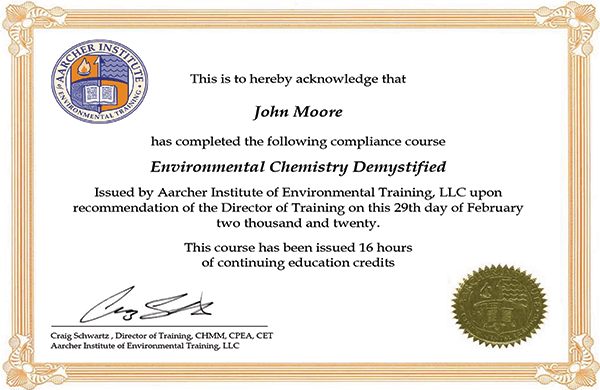Chemistry Training for Non-Chemists.
Applied Chemistry for EHS Professionals™ has been delivering a powerful and practical understanding of chemistry for more than 20 years. This course was previously presented in two parts (Chemistry Demystified and Chemistry Advanced) but has been refined and updated as a single 3-day course to meet the needs of today’s EHS professional . This important course is valuable for all EHS professionals, at any career stage.
Arm yourself with a solid working knowledge of environmental chemistry.
Stronger understanding of chemistry allows EHS professionals to better understand nearly all aspects of their work, including selecting appropriate laboratory analysis and interpreting results, site characterization, toxicology, monitoring data, regulatory and permit limits, and environmental and human health hazards. You will be better prepared to predict and understand fate and transport of chemicals in environmental media, select sampling and monitoring strategies, evaluate laboratory analytical data, diagnose unexpected analytical results, and make more informed EHS decisions.
Chemicals don’t simply “go away” when they are released to the environment, so how do we predict the their fate? Why do some permits prohibit releasing wastewater into the environment with concentrations of substances that we could otherwise drink? Why are site characterization samples often like potato chips – you don’t know if you’ve had enough until you’ve already had too many? What the heck is an MS/MSD, and why should I care? Who was the”Susan Lucci” of Chemistry, that is, what chemist was nominated for a Nobel Prize 29 times but never won one?
Who should attend this course?
Applied Chemistry for EHS Professionals™ is valuable for anyone who has corporate or regulatory EHS responsibilities, such as exposure evaluation and controls, environmental permit implementation, monitoring and sampling, waste characterization, pollution prevention, identifying pollutant sources, receiving laboratory analyses, storing hazardous materials, or diagnosing changes in emissions and discharges.
Do you receive environmental technical reports or are asked to sign documents to be submitted to a regulatory agency? Need a place to start learning about why certain samples are collected, the techniques involved in sampling, and the analyses of those samples? Need the ability to better evaluate Safety Data Sheets or evaluate employee exposure? Do you characterize waste streams or sign manifests and want to feel more confident? Are you responsible for determining if your facility is subject to regulations based on chemicals in your waste streams? Do you have permit reporting responsibilities? Are you involved in site cleanup activities? Do you need to understand what people engaged in those activities are talking about? Puzzled by hazardous materials compatibility?
JOIN US for three interesting days discussing the chemistry that you wish you had learned or or don’t fully remember, with a focus on how chemistry applies to everyday environmental science matters.
Example titles of those who attend this course include:
- Environmental Compliance Manager/Staff
- Safety Manager / Safety Specialist
- EHS Director/Staff
- Remediation Engineer/Technician
- EHS Project Manager
- Permit Specialist
- Laboratory Assistant
Applied Chemistry for EHS Professionals™ does not require attendees to have any background in chemistry. Aarcher Institute instructors draw on many years of applied, practical environmental chemistry experience to provide straightforward, understandable explanations of the chemical process and issues that affect important environmental compliance management considerations.
What is the course format?
Applied Chemistry for EHS Professionals™ is presented as a series of topical modules over a 3-day period, with frequent breaks throughout the day, and a 1-hour break for lunch. Case studies and real-world examples are used throughout the course to illustrate important chemical processes and how they affect, and are affected by environmental media.
The course is offered in pleasant and easily accessible locations, and training venues are selected to allow you to escape distractions and focus on the presented material in a professional setting. All locations offer wireless service and Internet access so you can stay connected.
Discussions among instructors and participants is encouraged to clarify specific information or explore various aspects of applied chemistry.
What does this course deliver?
Applied Chemistry for EHS Professionals™ provides participants with the chemistry knowledge necessary to succeed as an EHS professional.
You will return from this course with a course binder; useful references; example documents and other tools to assist you in the future; instructor contact information for followup questions; and your notes from the presentations and discussions.
At completion of the course, you will receive a certificate for your records. If you maintain professional credentials requiring continuing education credits, Applied Chemistry for EHS Professionals™ has been approved by all environmental, safety, legal, and engineering certifying bodies.
